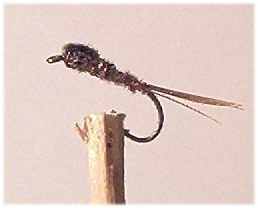tied by Rene Zillmann, Germany

This pattern do not use a thread in it's construction. The thread is replaced by fine wire. This reduces the amount of materials needed and speeds up the tying process. The wire is used for ribbing, weighting and general construction purpose.
For me the most difficult issue was the procurement of the wire. The pattern askes for a very thin wire, I didn't got it through my fly-shops. Finally I found it in a electronic shop. I used fine cable designed for delicate electronic construction. If you open the cable you find 24 or 36 very thin and smooth wires. It worked great on thsi fly.
You work with the wire like you would work with thread. Lock the wire at the hook's eye with the regular lock knot. Form a neat thorax foundation, best is to form it cylindric. Three layer should be fine. Then advance the wire to the hook bend and ty in the pheasant tail fibers. Twist wire and fibers to form a rope. Using this rope form the abdomen. Continue wrapping to come over the thorax foundation. Then open the rope and take one or two wraps with the wire to secure it. go under the thorax back an the rear side of the thorx and do one wrap. Fold the pheasant fibers back and secure with one wrap. Repeat in fromt of the thorax and again on the back side of the thorax. You have no a triple wing case. Execute a whip finish on the back side, cut off excess material and varnish.
Hans has a better description and more background information on his site.
Pattern | |
| Hook: | Standard dry hook, sz. 16 or 18 |
| Thread: | None, fine wire is used instead |
| Wire: | fine copper wire |
| Weight, Underbody: | Copper wire |
| Tail: | Pheasant tail fibers |
| Abdomen: | Pheasant tail fibers twisted with fine copper wire |
| Thorax: | Pheasant tail fibers twisted with fine copper wire |
| Wing case: | Pheasant tail fibers |